South Korea Drug Delivery Devices Market Size
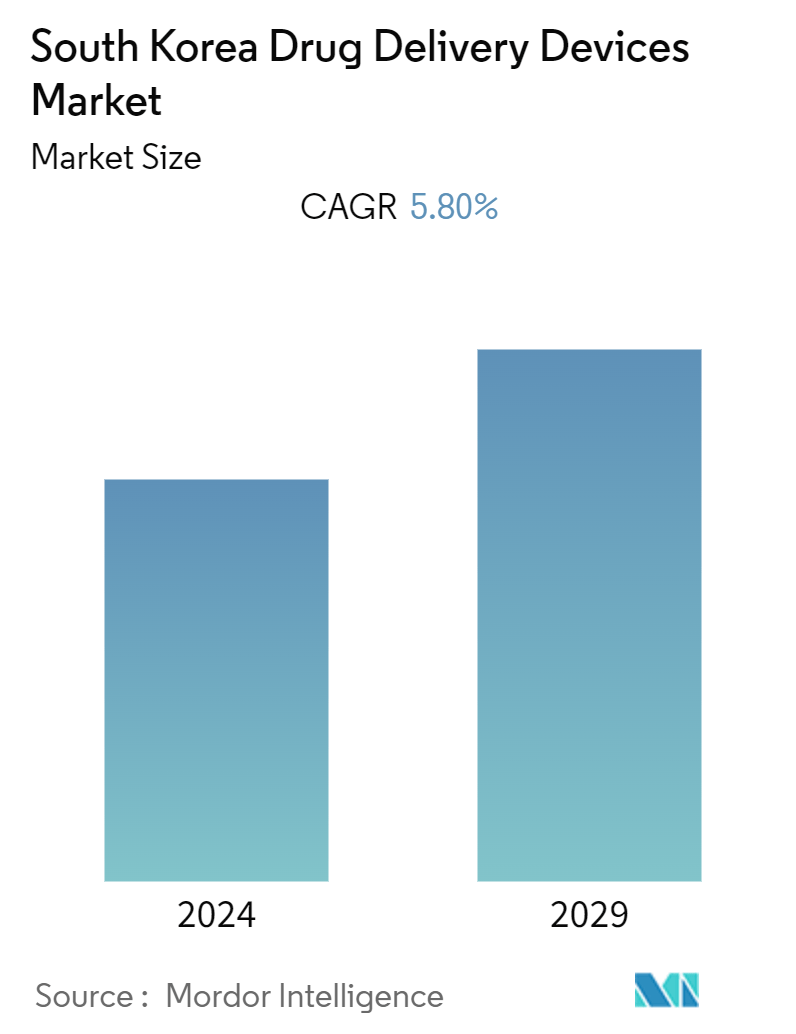
| Study Period | 2019 - 2029 |
| Base Year For Estimation | 2023 |
| Forecast Data Period | 2024 - 2029 |
| Historical Data Period | 2019 - 2022 |
| CAGR (2024 - 2029) | 5.80 % |
| Market Concentration | Medium |
Major Players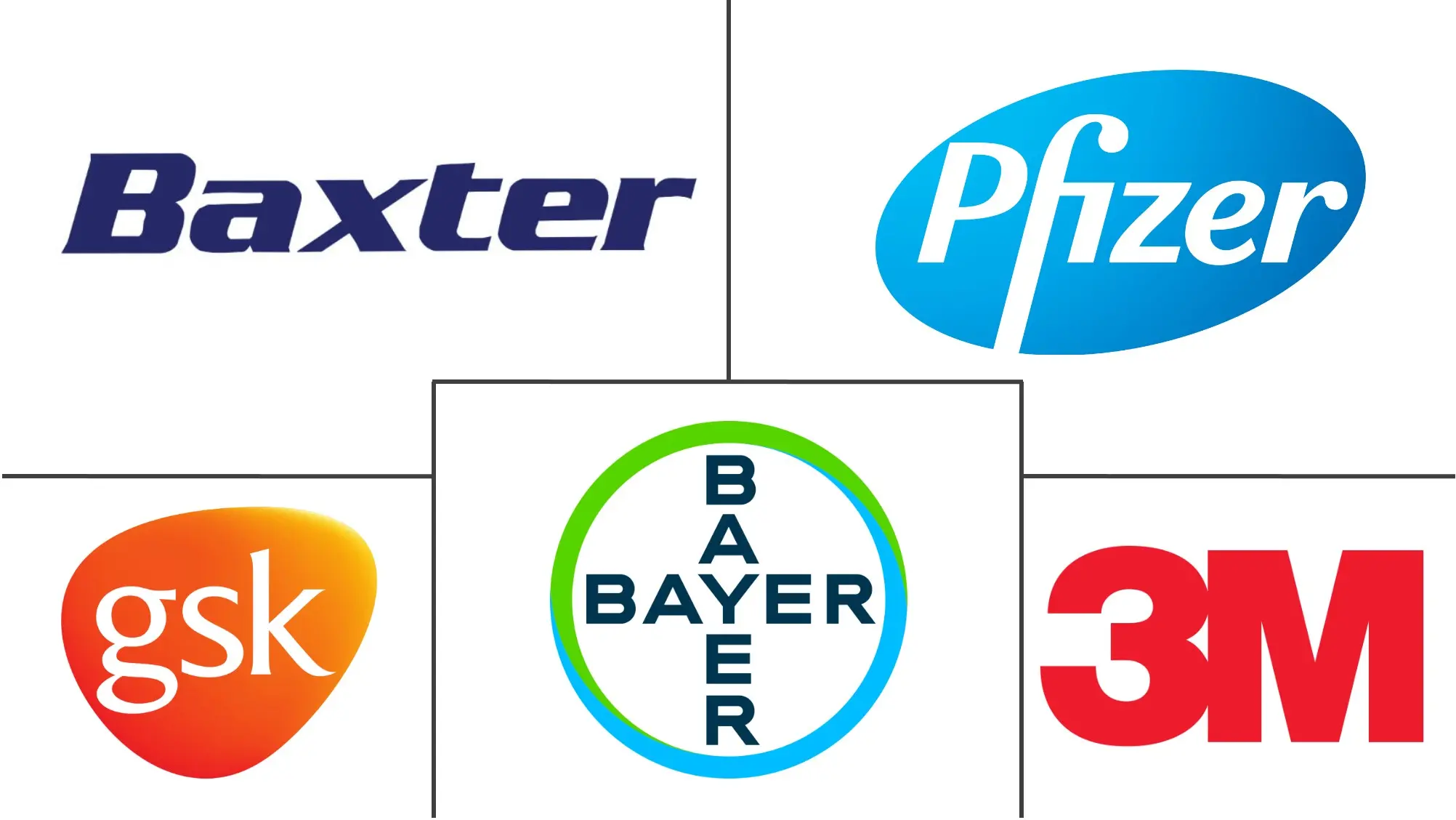
*Disclaimer: Major Players sorted in no particular order |
South Korea Drug Delivery Devices Market Analysis
The South Korea Drug Delivery Devices Market is expected to register a CAGR of 5.80% during the forecast period.
Drug delivery devices are specialized tools for delivering drugs or therapeutic agents via a specific route of administration. In South Korea, the demand for these devices has primarily increased due to the increasing prevalence of chronic diseases, such as cardiovascular diseases (CVD) and cancer. For example, according to an article published in PubMed Central in May 2022, 274,488 new cancer cases were anticipated to occur in Korea in 2022, with thyroid cancer predicted to be the most common type of cancer, followed by lung, colon, rectum, breast, and stomach cancer. Therefore, various types of drug delivery devices play an important role in targeted drug therapy for chronic diseases, thereby boosting the growth of the market.
Further, as the prevalence of chronic diseases such as diabetes, cardiovascular diseases, and respiratory disorders rises in South Korea, there is a growing need for efficient drug delivery mechanisms. Devices such as insulin pumps, inhalers, and injectors cater to these patient populations. For instance, according to the International Diabetes Federation, in 2022, 3.9 million people were expected to be diagnosed with diabetes in South Korea by 2030, and this number is projected to reach 3.9 million by 2045. Thus, the expected increase in diabetes cases in South Korea is anticipated to increase demand for drug delivery devices, thereby boosting market growth.
Market players are driving growth by developing new products, acquiring other companies, and forming strategic collaborations. These initiatives are expected to significantly impact the market during the forecast period. For instance, in March 2022, Futura Medical, a developer of transdermal DermaSys drug delivery technology, inked a licensing deal with Menarini Korea, a Menarini Group subsidiary. The agreement granted Menarini Korea exclusive rights to market Futura's gel-based Erectile Dysfunction (ED) treatment, MED3000, in South Korea.
Similarly, in November 2022, Medicox Co. Ltd signed an exclusive distribution contract with an oral drug delivery platform developer, ORAMED Pharmaceuticals, for distribution rights for ORAMED's oral insulin in South Korea.
High burdens of chronic diseases, notably diabetes and cancer, alongside ongoing product launches, are poised to drive market growth through the forecast period. Yet, rising infection risks and stringent regulatory hurdles for approval of drug delivery devices pose notable constraints.
South Korea Drug Delivery Devices Market Trends
Injectable Segment Expected to Register High Market Growth in the Forecast Period
The injectable segment is poised for rapid growth driven by several factors, including the rising burden of chronic diseases, the benefits and convenience of self-injectors, and the growth of the biologics market. In particular, the increasing prevalence of chronic diseases such as diabetes in South Korea is driving the overall use of syringes and self-injectable devices.
Market participants are actively developing new products and pursuing acquisitions and partnerships to capitalize on this growth opportunity. For example, in April 2022, GC Pharma began supplying HugPEG, an injection aid for Neulapeg (pegfilgrastim), to neutropenia patients who must administer the drug themselves. HugPEG enables users to attach and administer the pre-filled syringe combined with a needle guard, providing a more convenient and efficient way to administer injections compared to existing devices that give injections indirectly.
Further, the increasing development of injectable drug formulations is expected to boost demand for drug delivery devices and is likely to contribute to the segment’s growth over the forecast period. For instance, in May 2024, Sciwind Biosciences Co. Ltd and HK Corporation entered a licensing and partnership agreement. The collaboration aims to develop and commercialize ecnoglutide injection (XW003), a cutting-edge GLP-1 analog designed to address type 2 diabetes, obesity, and MASH, specifically in the South Korean market.
Overall, the injectable segment is expected to experience significant growth over the forecast period owing to factors such as growing demand for injectables and increasing development of injectable formulations and product launches of injectable drug delivery devices.
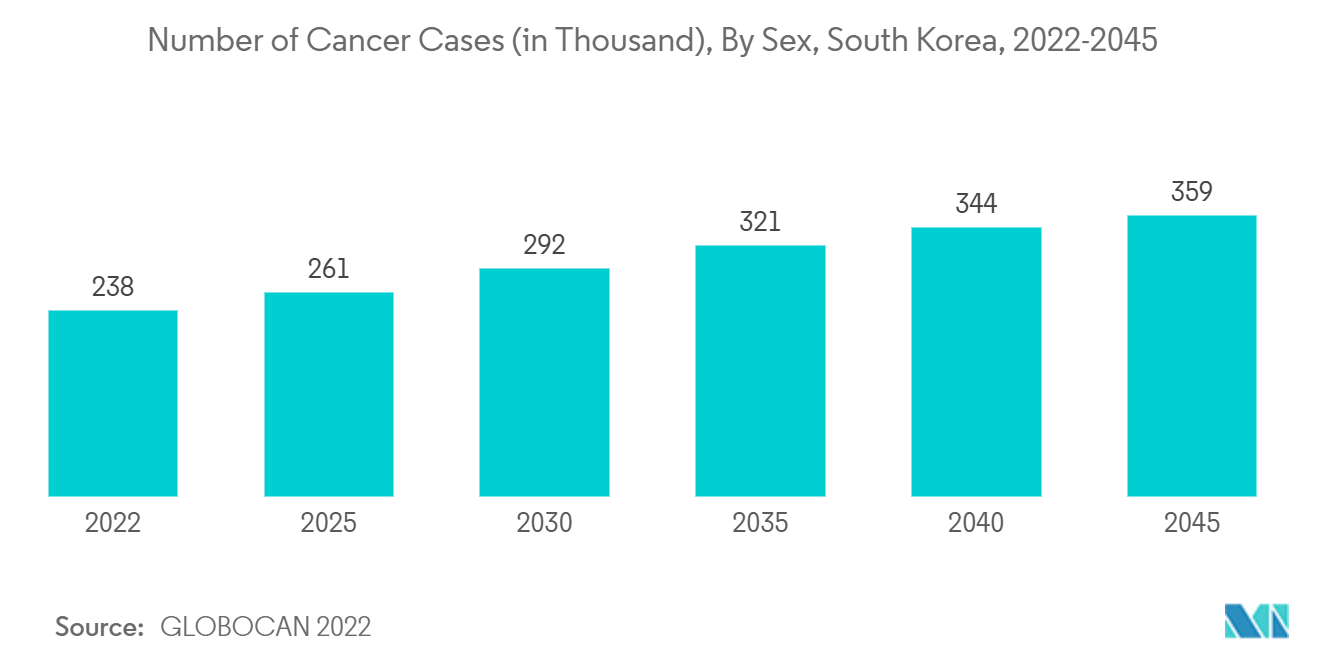
Topical Segment Expected to Grow Further During the Forecast Period
Topical drug delivery devices are designed to deliver medication through the skin of the patient. Various research studies conducted by South Korean researchers have demonstrated the high effectiveness and widespread use of topical drug delivery devices, which are expected to create more demand and growth opportunities for these devices in South Korea.
Topical drug delivery devices are widely used in South Korea, as demonstrated by research studies showing their high effectiveness and widespread use. For instance, a study published in July 2022 by the researchers of Pusan National University in Biomaterials Research emphasized the advantages of transdermal drug delivery systems such as hyaluronic acid-based dissolving microneedle patches. These patches offer a low rejection rate, ease of administration, persistence, and convenience for patients.
The study also noted that the transdermal drug delivery system is used for pharmaceuticals as well as for cosmetics, and it avoids the local build-up of the medicine concentration and nonspecific delivery to non-targeted tissue. Topical transdermal patches have applications in the management of diabetes, dermatitis, metabolic dysfunctions, and other conditions.
In October 2022, a study published in the Archives of Dermatological Research by researchers of Dongshin University, South Korea, highlighted the high efficacy of transdermal drug delivery using biodegradable hyaluronic acid MN patches (BHMN patches) for delivering drugs through the dry and sensitive skin of atopic dermatitis (AD) patients. The study demonstrated that BHMN patches can be an effective way to manage AD.
Furthermore, in March 2022, Futura Medical licensed its transdermal DermaSys drug delivery technology for an ED treatment to Menarini Korea for commercialization in South Korea. Similarly, in November 2022, ORAMED Pharmaceuticals signed an exclusive distribution deal with Medicox Co. in South Korea for its oral insulin delivery platform. Thus, such strategic activities by market players in the country are expected to contribute to the growth of the segment over the forecast period.
Therefore, due to the wide-ranging applications and high efficacy of topical drug delivery devices, the topical segment is expected to witness significant growth over the forecast period.
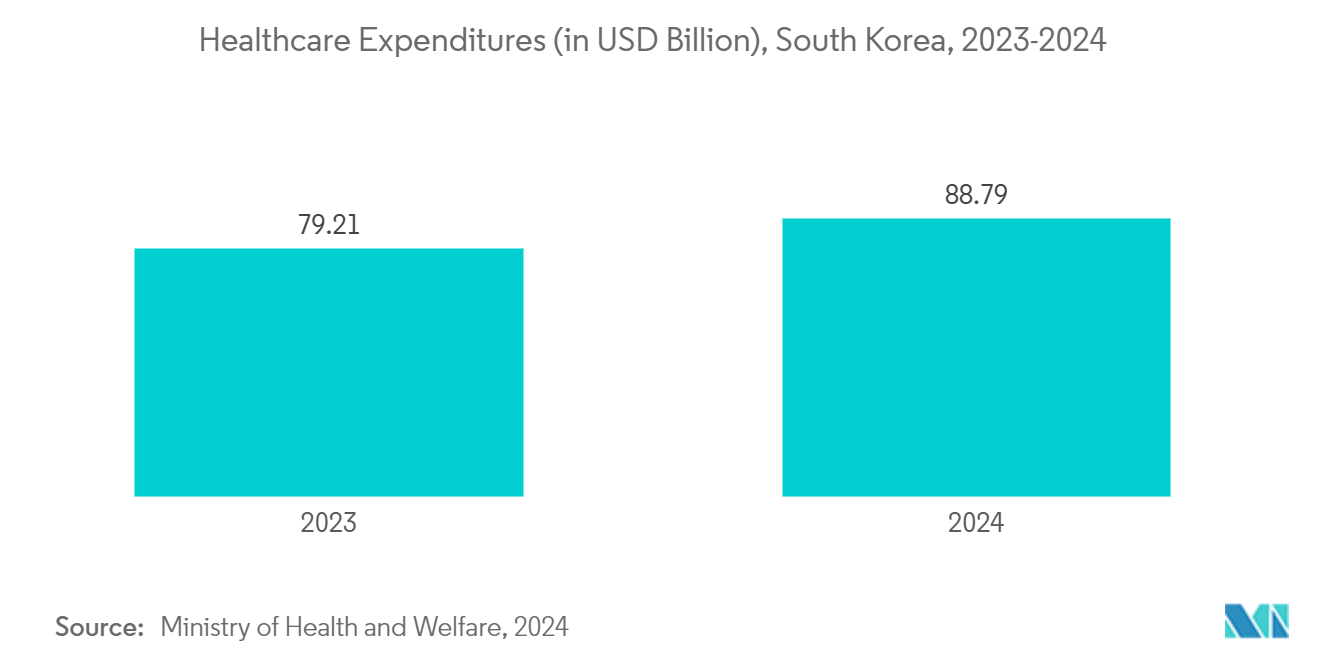
South Korea Drug Delivery Devices Industry Overview
The market studied is semi-consolidated and comprises international as well as local players. South Korea is a highly developed country with a well-structured healthcare system. As a result, many global players in the drug delivery devices market are present in the country. The competitive landscape includes an analysis of some international and local companies that hold market shares and are well known, including 3M, Baxter International, Bayer AG, F. Hoffmann-La Roche AG, GlaxoSmithKline PLC, Johnson & Johnson, Merck & Co., Novartis AG, Pfizer Inc., and QuadMedicine.
South Korea Drug Delivery Devices Market Leaders
-
Bayer
-
Baxter International
-
GlaxoSmithKline
-
3M Company
-
Pfizer Inc.
*Disclaimer: Major Players sorted in no particular order
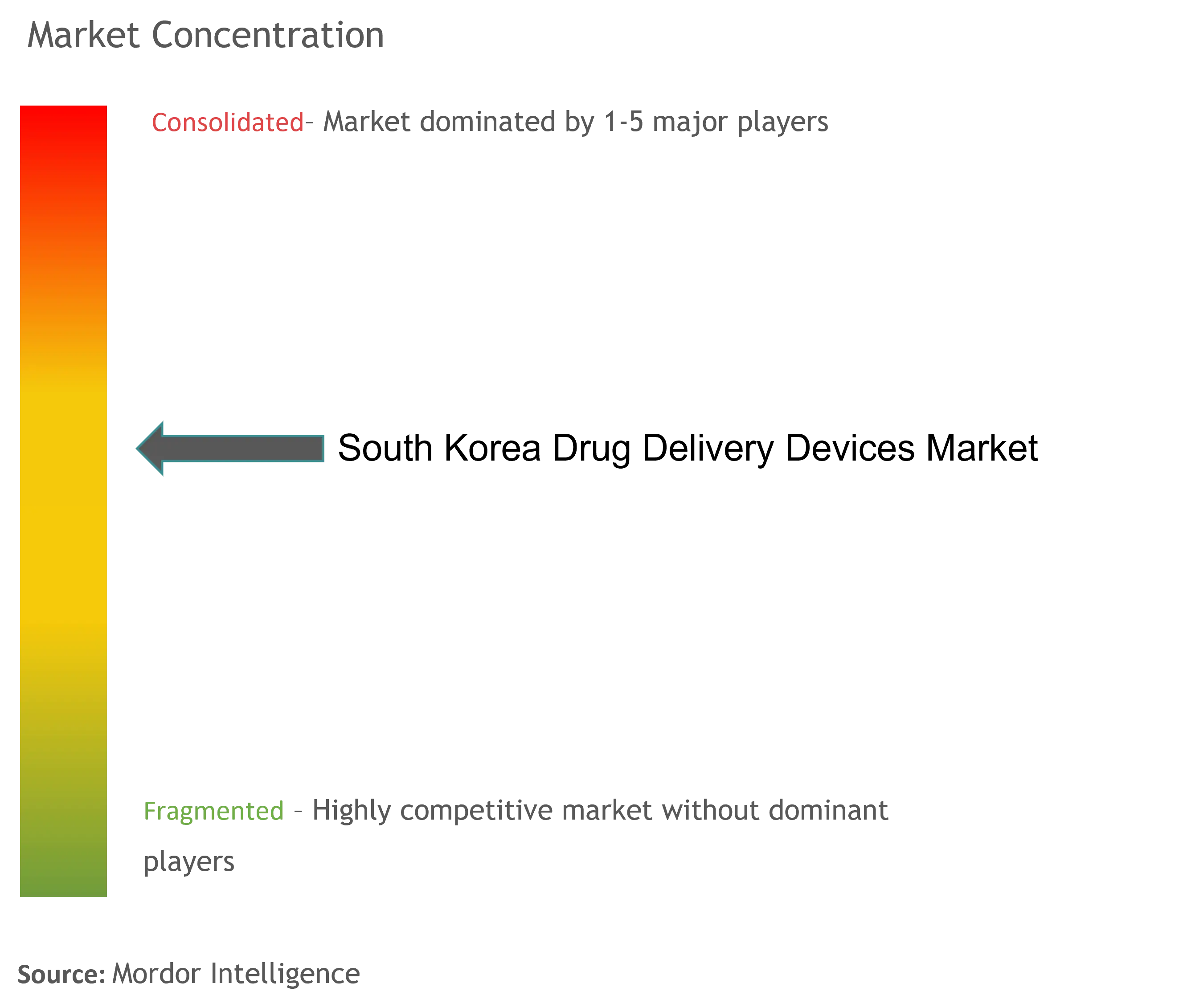
South Korea Drug Delivery Devices Market News
- January 2024: A team of researchers led by Professor Myoung-Hwan Park from Sahmyook University in South Korea developed a light-responsive nanofiber-based novel drug delivery system (DDS) targeting skin cancer.
- December 2023: Medtronic announced the termination of its acquisition deal with EOFlow. Initially valued at USD 738 million, the agreement was inked in May 2023, with Medtronic aiming to purchase the South Korea-based insulin patch pump manufacturer. EOFlow is renowned for its flagship product, the EOPatch, which stands out as a tubeless, wearable, and entirely disposable insulin delivery system.
South Korea Drug Delivery Devices Market Report - Table of Contents
1. INTRODUCTION
1.1 Study Assumptions and Market Definition
1.2 Scope of the Study
2. RESEARCH METHODOLOGY
3. EXECUTIVE SUMMARY
4. MARKET DYNAMICS
4.1 Market Overview
4.2 Market Drivers
4.2.1 Increased Prevalence of Chronic Diseases
4.2.2 Requirement of Controlled Drug Release
4.3 Market Restraints
4.3.1 Risk of Infections During Usage and Stringent Regulatory Guidelines
4.4 Porter's Five Forces Analysis
4.4.1 Threat of New Entrants
4.4.2 Bargaining Power of Buyers/Consumers
4.4.3 Bargaining Power of Suppliers
4.4.4 Threat of Substitute Products
4.4.5 Intensity of Competitive Rivalry
5. MARKET SEGMENTATION (Market Size By Value - USD)
5.1 By Mode of Administration
5.1.1 Injectable
5.1.2 Topical
5.1.3 Ocular
5.1.4 Other Modes of Administration
5.2 By End User
5.2.1 Hospitals
5.2.2 Ambulatory Surgical Centers
5.2.3 Other End Users
6. COMPETITIVE LANDSCAPE
6.1 Company Profiles
6.1.1 3M
6.1.2 Baxter International
6.1.3 Bayer AG
6.1.4 F. Hoffmann-La Roche AG
6.1.5 GlaxoSmithKline PLC
6.1.6 Johnson & Johnson
6.1.7 Merck & Co.
6.1.8 Novartis AG
6.1.9 Pfizer Inc.
6.1.10 QuadMedicine
- *List Not Exhaustive
7. MARKET OPPORTUNITIES AND FUTURE TRENDS
South Korea Drug Delivery Devices Industry Segmentation
As per the scope of the report, drug delivery devices are specialized tools used for the delivery of a drug or therapeutic agent through a specific route of administration. The devices are used one or more times for medical treatments. These devices are also used for safe and effective drug delivery.
The South Korean drug delivery devices market is segmented by mode of administration and end user. By mode of administration, the market is segmented into injectable, topical, ocular, and other modes of administration. By end user, the market is segmented into hospitals, ambulatory surgical centers, and other end users.
The report offers the value (in USD) for the above segments.
| By Mode of Administration | |
| Injectable | |
| Topical | |
| Ocular | |
| Other Modes of Administration |
| By End User | |
| Hospitals | |
| Ambulatory Surgical Centers | |
| Other End Users |
South Korea Drug Delivery Devices Market Research FAQs
What is the current South Korea Drug Delivery Devices Market size?
The South Korea Drug Delivery Devices Market is projected to register a CAGR of 5.80% during the forecast period (2024-2029)
Who are the key players in South Korea Drug Delivery Devices Market?
Bayer, Baxter International, GlaxoSmithKline, 3M Company and Pfizer Inc. are the major companies operating in the South Korea Drug Delivery Devices Market.
What years does this South Korea Drug Delivery Devices Market cover?
The report covers the South Korea Drug Delivery Devices Market historical market size for years: 2019, 2020, 2021, 2022 and 2023. The report also forecasts the South Korea Drug Delivery Devices Market size for years: 2024, 2025, 2026, 2027, 2028 and 2029.
South Korea Drug Delivery Devices Industry Report
Statistics for the 2024 South Korea Drug Delivery Devices market share, size and revenue growth rate, created by Mordor Intelligence™ Industry Reports. South Korea Drug Delivery Devices analysis includes a market forecast outlook to for 2024 to 2029 and historical overview. Get a sample of this industry analysis as a free report PDF download.



